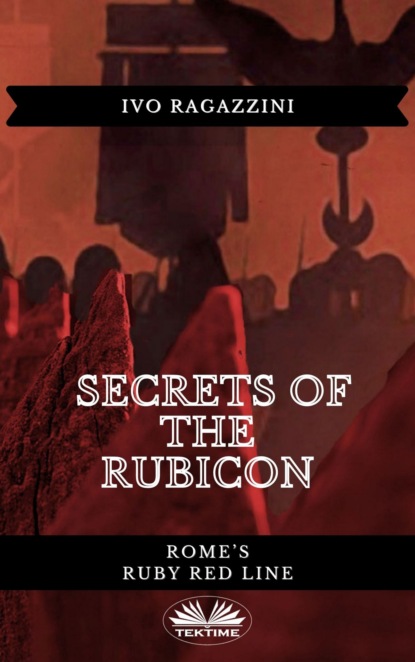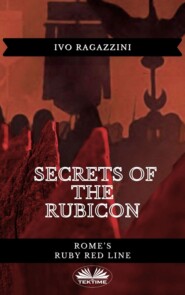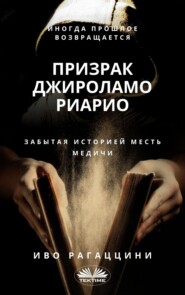По всем вопросам обращайтесь на: info@litportal.ru
(©) 2003-2024.
✖
Secrets Of The Rubicon
Настройки чтения
Размер шрифта
Высота строк
Поля
I only add that this book, is not a rehashing of other works, and will lead you to discover many other mysteries and stories about the history of Rome, the Rubicon and ancient Romagna for the first time that you may never have suspected.
Straddling somewhere between an essay and historical account, the way is opened through twenty centuries of history and paths that have never been travelled before. This book is based on historical research, forgotten local legends, etymological research and observations that have never been made before. For the first time, light is shed on the darkness of those disputed events on the ruby-red border named the Rubicon. A unique story has been created that refers to nothing that has been written previously on the subject.
In particular, this book will answer the following questions for the first time:
What really was the Rubicon?
Why was it given that name?
Who for and why was the border created long before Caesar?
What was Romagna at the time?
What were the symbols and insignia used by Caesar's Gallic legions?
What insults did the Roman legionaries and warriors of that time shout?
What was the New Year's feast at the time of Caesar?
Why did Caesar cross the Rubicon immediately after the New Year's elections?
And, to tell the truth, many other things that you may never have guessed at, in a crescendo of facts and revelations that will reveal many facts and places that have been forgotten by history during that turbulent period of transition from republic to the Roman Empire.
So, enjoy reading and rediscovering the history of the Rubicon as well as many other facts.
Where the Rubicon lay was also the road to Rome
Romagna towards the end of 50 BCE (before common era). Julius Caesar and his military escort turned away from Ravenna to travel to Cesena
"Ubi est Rubico finis, etiam est Roman Via" (Where there is the Rubicon border there is also the road to Rome), Caesar told the young escort commander Quintus Hortensius who was sitting next to him on a military chariot, when they travelled from Ravenna they crossed the road leading to Cesena, which was guarded by the Tenth
legion. It was one of the places Caesar, already in debt for a sum of over one hundred million sesterces, was building in Romagna near the border called the Rubicon.
"Did you know that Hortensius?" added Caesar.
"I've never been there but once a centurion told me something like that," replied Commander Hortensius in Latin mixed with Gallic.
"Did he at least tell you who built it and why it was called Puniceus Rubicon
?" asked Caesar.
"No."
"Then that centurion didn't explain very much to you," smiled Caesar.
"Would you teach me, General Caesar?"
"Very well, Commander Hortensius."
"Many years ago, when there was no Romanavia
, a tribune called Flaminius built a road that led from Rome to Rimini in this land that was named Flaminia in his honor."
"However, a few years later a Punic general named Hannibal crossed the Alps and surprised Rome from northern Italy."
"So the Tribune Flaminius was appointed Consul and the Senate quickly ordered him to defend the road to Rome, which he had just finished building, and to construct a defensive line to block access and prevent Hannibal descending towards Rome."
"And so, the consul Flaminius, built that series of lines of defenses on a few rivers and trenches between the current Caes Arena and Ariminium and called it Puniceus Rubico
. These defenses were hurriedly constructed because he had to halt the Punic Hannibal's descent towards the Via Flaminia, the only road that led from the north directly to Rome," explained Caesar.
"Thank you Caesar. Why do they call it Rubico finis today?" asked Hortensius.
"Because it is a ruby-red line that is still impassable to enemies and protected by the Gods of Rome. These defenses were cordoned off by palisades made of maritime pines that were taken from the enormous pine forests you see around here. It was then painted rubico,
the sacred color of Rome, and made inviolable by the Gods with a sacred ritual performed by a few Flaminian
priests who placed the terrifying spirits of our Patres to guard the border and punish whoever dared to cross it armed."
"So, it was forbidden to cross the Rubicon armed for this reason?" asked Hortensius a little alarmed.
"Certainly, but I should add they also placed legionaries to guard it, because sometimes the gods alone are not enough. And seeing that now the Punic threat has disappeared, most people only call it the Rubicon and leave it standing to prevent any barbarians and enemies from the north descending towards Rome." Smiling Caesar added, "Including Roman and Gallic legionaries, of course."
"Therefore Rubicon means ruby-red, noble Caesar?"
"Of course, it is the sacred color of Rome, the ruby color that you still see on all our dispatches and red-bordered notes that we use and receive from Rome,"
replied Caesar.
"Thank you Caesar, I didn't know. Could you also explain why the Roman legionaries are afraid to cross it, while those of Gallic origin are not?"
"Because whoever is Roman and crosses it becomes a traitor and, it is said, the Gods of Rome will strike them down with a bolt of lightening, while whoever is not Roman will be defeated by the soldiers of Rome helped by the Gods. Or at least so some Flaminia priests say, who every now and then perform a ritual to curse anyone who tries to cross it bearing arms," Caesar answered with a smile.
"With all these curses surrounding it, wouldn't you be afraid to cross it also, noble Caesar?"
After thinking a while Caesar replied: "A little, yes, but not much."
"So it is only because of the Flaminian priests' sacred protection that our Gallic legionaries would be willing to attack it, while the Roman legionaries would not," asked Hortensius, thoughtfully.
"Of course, the problem is not only military, but religious also," replied Caesar smiling.
"Is the Rubicon still defended by that red palisade?" asked Hortensius.
"Yes. Those ruby-red painted poles are occasionally restored and rededicated by a Flamen Dialis
and must eternally protect and ensure people know where the Rome border is located, beyond which it is forbidden to march armed. Once Hannibal was defeated, that border was simply called Rubicon and now it has remained the border for entering and leaving the Roman territory," explained Caesar.
"I read a report that says: two legions under Pompey have left the Rubicon and lined up almost below Cesena," said Hortensius, increasingly curious to learn new things.










